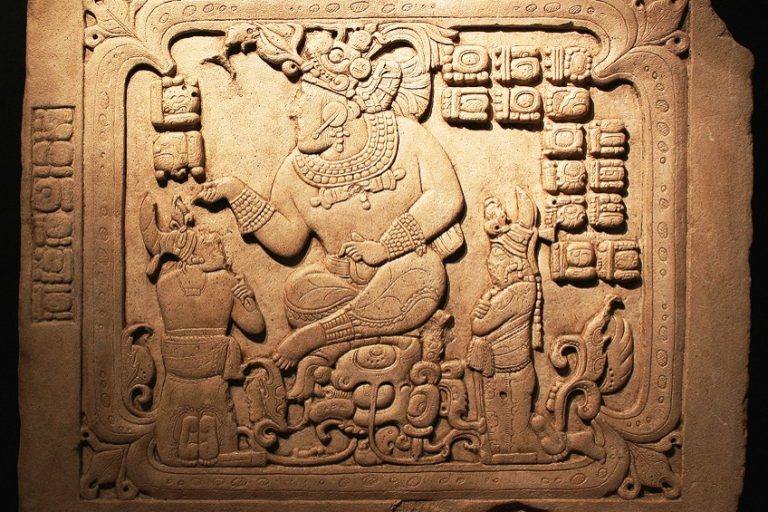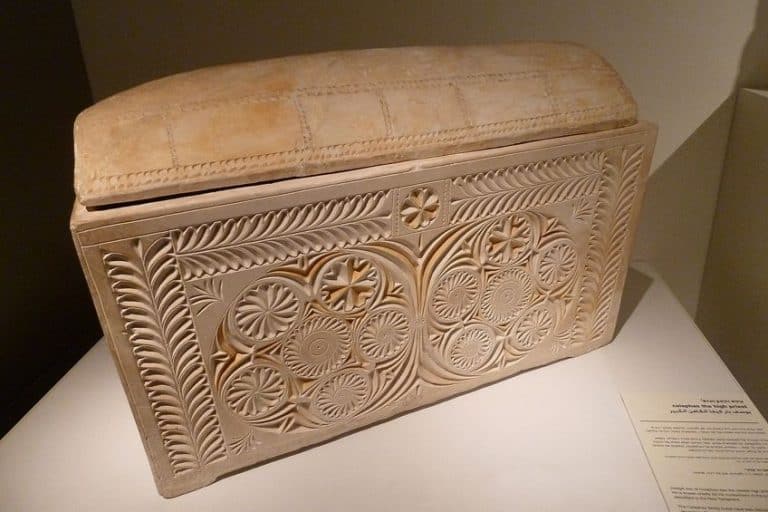Expressionism Art – A History of the Expressionist Movement
Expressionism existed as a period within art that abandoned realistic and accurate representations of scenes and subjects in an attempt to capture the subjective perspective of the artists. Seen as a modernist movement, Expressionism art emerged in Germany just before World War I, before spreading across the world. This broad movement developed into a niche exploration of art known as German Expressionism, which went on to define the Expressionist movement throughout its reign. In this article, we will introduce you to the style and characteristics of Expressionism, as well as its development through German Expressionism and a few famous artists who shaped it. Keep reading for more about this fascinating art movement!
An Introduction to Expressionism Art
Arising in Germany in 1905, the Expressionism years encompassed an Avant-Garde movement that leveraged exaggerations and distortions within artworks to accurately depict 20th-century life from a subjective perspective. This style of art developed before the start of the First World War and was popular during the Weimar Republic in Germany, before its decline in 1920. In addition to Expressionist painting, the movement extended itself to a wide range of artistic categories, including literature, drama, and cinema.
Seen to exist as essentially a modernist movement, Expressionism originated during a period of intense change and upheaval across Europe. During this time, society was developing at a rapid rate due to the industrialization, which took the continent by storm, as well as the chaotic state of the world that was present within countries leading up to World War I. This led to German artists responding to these two important events through the artworks they created.
The inventions within the production and communication sphere brought about a sense of apprehension among the general public. This was due to the expansion in technology in addition to the radical urban development of major cities, which resulted in intense feelings of isolation and detachment from the natural world.
These vivid emotions began filtering into art production at the time, as artists expressed their anxieties through a heightened use of color, jagged angles, flattened forms, and heavily distorted figures.
As the beginning of the First World War loomed, themes related to the grotesque appeared in Expressionist art. Artists began to experiment with printmaking, as it was an efficient way to quickly distribute their work to a larger audience. Additionally, Expressionism art tackled political and social causes, which spread far and wide, and helped carry the emotional significance present in Expressionist artists’ works beyond traditional artistic styles.
Initially, many of the Expressionist artists supported the idea of war, as they believed that it would lead to the defeat of the middle-class society, along with its widespread materialistic tendencies and cultural limitations. However, as the artists joined the cause and were recruited, their personal experience of the war destroyed their previous feelings of optimism and hope. This led to many artists experiencing mental breakdowns, with these emotions being channeled into the works they created.
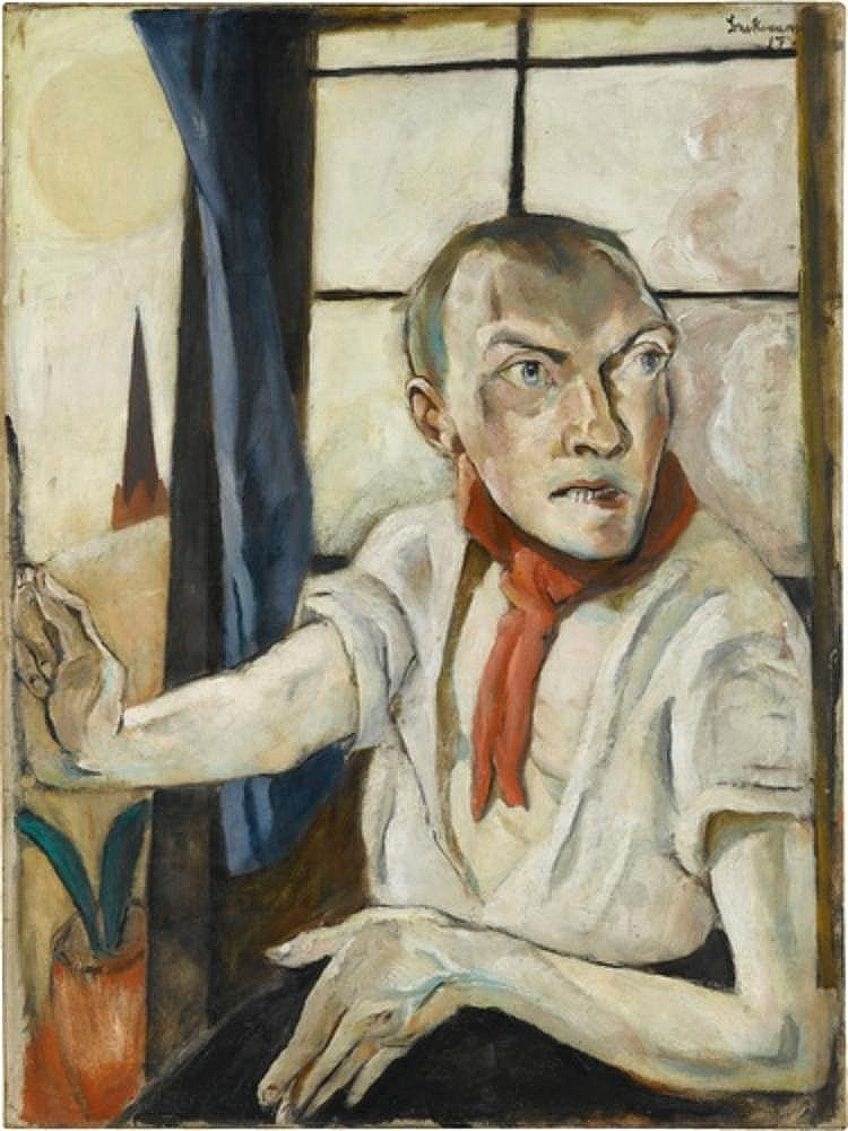
Subsequently, artworks of the Expressionism movement indicated the broken minds and bodies of the artists who were affected, which gave viewers a personal insight into the gruesome world that existed on the battle lines. Thus, Expressionist art presented a distorted view of the world for an emotional effect as opposed to portraying the grim reality of war. This was done to express the emotional experiences of the artists, in addition to their raw and truthful feelings and ideas about the reality in which they lived.
In their quest for authenticity, Expressionist painters depicted the world exactly as it felt rather than how it looked, taking inspiration from the bold, vibrant, and introspective paintings that were created in the Post-Impressionist era. Artists dismissed the predominant stylistic conventions that had dictated visual creation at the turn of the 20th century in an attempt to reinvigorate art with conviction and an expressive force.
Precursors of the Expressionism Movement
The origins of the Expressionism movement can be linked to artists such as Edvard Munch, Emil Nolde, Vincent van Gogh, and Henri Matisse. Each artist began to display signs of a departure from lifelike portrayals in their later works, as they preferred to capture the personal thoughts and outlooks of their subjects.
Thus, the style of Expressionism made subjective thoughts a defining aspect of the movement, as artists rejected realistic and precise representations in favor of exaggerations and distortions that they believed to carry a greater impact.
Out of the artists who were thought to influence the development of Expressionism, Munch and Van Gogh existed as the leading pioneers of movement, as it was their artwork that held the most influence over the movement’s distinct characteristics. Both artists made use of unnatural colors, dynamic brushstrokes, and overstated textures within their works, which went on to become essential characteristics of Expressionism art. This resulted in artworks that offered a subjective view of the current reality that existed, as the works gave a glimpse into the mind of the artists at the time.
Munch’s The Scream, painted in 1893, exists as a prominent example of the beginning of Expressionism. Very little attention was given to an accurate portrayal of the subject and the landscape, as a ghoulish figure is seen standing in a background of whirling lines and harsh, contrasting colors. In doing so, Munch managed to convey the deep pain and intense anguish of the figure, which was seen as more important than the actual style and composition of the work.
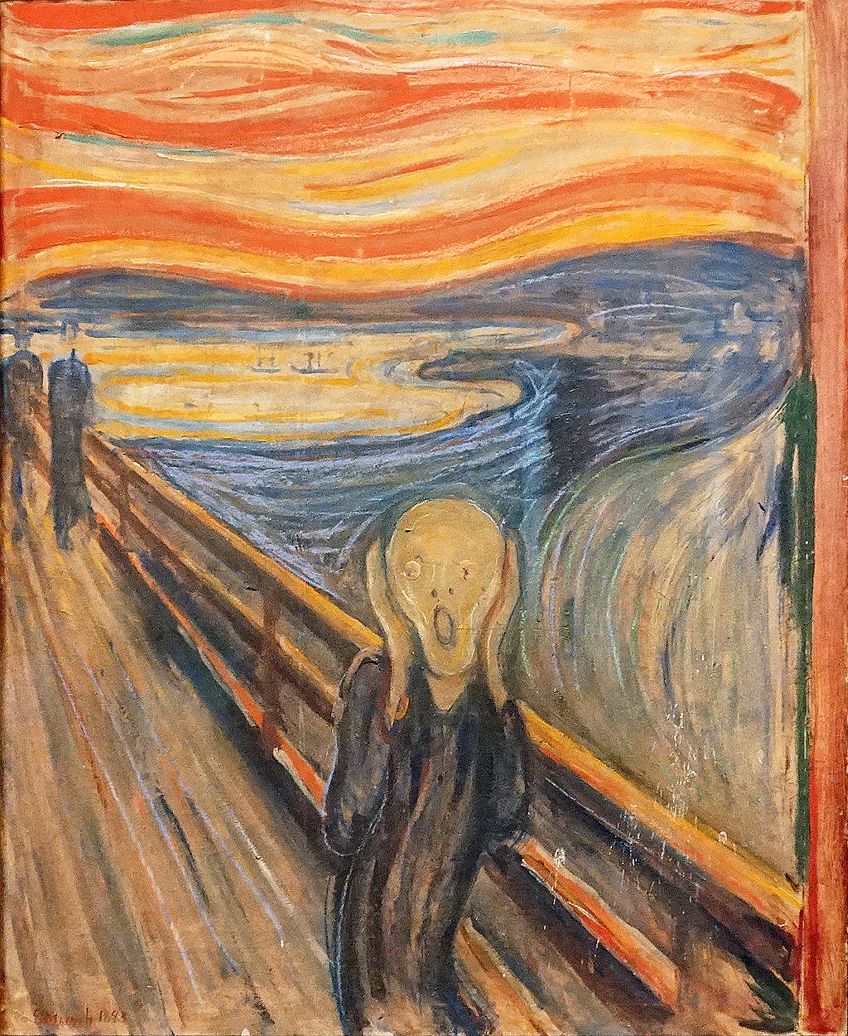
Coining the Name of the Movement
The term “Expressionism” was popularized by several writers in 1910 but was supposedly coined by Czech art historian Antonin Matějček, who intended the term to mean the opposite of Impressionism. Where Impressionist artists were thought to look externally to the real world when capturing instances such as nature and the human form, Expressionists were said to search inwards for a deeper meaning, so as to accurately express the landscape of their inner lives.
This distinction in style was created through the harsh subject matter that was depicted, as well as the unrestrictive brushwork, jagged forms, and intense colors. While some artists refused to refer to themselves as “Expressionists”, the notion of the movement was so revolutionary at the time that the term “Expressionism” came to represent many styles of Contemporary art. The movement also sparked the Neue Sachlichkeit movement, also recognized as the New Objectivity movement as a response to the emotional intensity of Expressionism.
Exploring an Expressionism Art Definition
Expressionism as an art movement was very broad and thus, was difficult to define. This was because it overlapped with other major movements within the modernist period, such as Vorticism, Cubism, Futurism, Surrealism, and Dadaism. Expressionism also spanned across different countries, mediums, and periods, meaning that it could not be defined by a strict set of aesthetic principles.
Rather, Expressionism was viewed as a tool of expression and social critique. While the term mainly applied to artworks that were created in the 20th century, it encompassed all works that were made in reaction to the dehumanizing impact of industrial development and the expansion of cities.
The label “Expressionism” sometimes conjured up feelings of angst, as depicted by the artwork that was created, as the movement existed as an artistic style that sought to portray subjective emotions and responses of ordinary people.
The Development of German Expressionism
As industrialization continued to grow in Europe, artists who started the Expressionism movement migrated to larger cities, bringing with them their ideas surrounding art creation. This led to other artists breaking away to form the subsequent German Expressionism movement, which was characterized by two notable groups known as Die Brücke and Der Blaue Reiter.
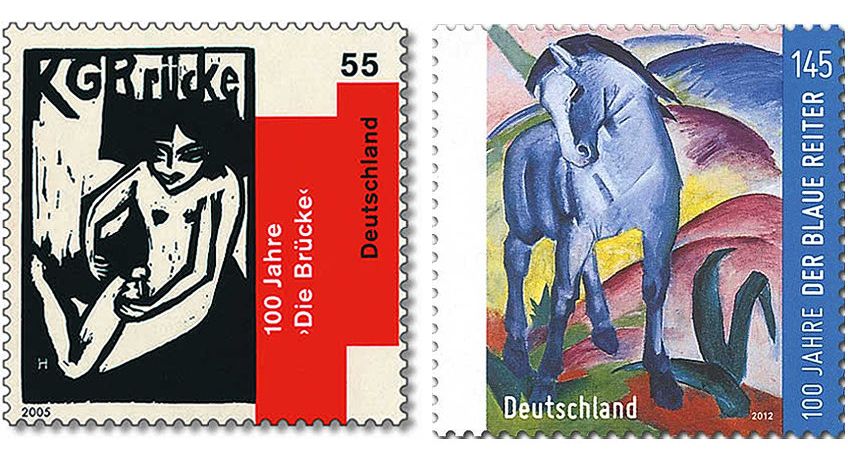
Die Brücke, which formed in 1905, was seen as the founding group of the German Expressionist movement, with Der Blaue Reiter only forming in 1911. Although both groups did not refer to themselves as German Expressionist groups, they shared studios, exhibited alongside each other, and went on to publish their works and texts together.
The Expressionism art movement emerged in various cities across Germany in response to the widespread anxiety that arose as an after-effect of industrialization. Artworks portrayed the increasingly despondent relationship that individuals held with both society and nature in the chaos that existed before and during World War I. Due to its success, Expressionism went on to inform other movements like Abstract Expressionism and Neo-Expressionism, and as such, it can be argued that the style continues to thrive today.
Characteristics and Influences of Expressionism Art
When considering this movement, it can be easy to wonder “What is Expressionism?” The style of Expression originally began in Germany and Austria, where a group of artists began creating artworks that made use of certain characteristics. These were works that centered around capturing emotions and feelings as opposed to what subjects looked like.
Striking colors and bold brushstrokes were used to emphasize the emotions that were present, which highlighted the importance of emotional expression over a realistic interpretation.
The Expressionist art movement demonstrated a heavy influence from other early 20th century movements such as post-Impressionism, Fauvism, and Symbolism. Artists made use of characteristics belonging to other movements when creating Expressionist art, which can be seen in their inclination to make use of arbitrary colors and discordant compositions, as inspired by the Fauves in Paris.
A primary characteristic of the Expressionism art movement was the exaggeration of subject matter. This, combined with swirling and swaying brushstrokes, managed to accurately express the turbulent emotional state that artists found themselves in, as a response to their anxieties about the modern world. Through their stark confrontation with the early-20th century urban world, artists were able to powerfully insert social critique into their work, which existed as an important characteristic.

This frank depiction of subject matter effectively demonstrated the new principles that existed when art was created and judged. Art was now meant to portray the inner worlds of the artists themselves rather than drawing from a mere depiction of the visual world. The artist’s feelings became more important when assessing the quality of an artwork, as an evaluation of the compositional aspects was no longer regarded as important.
Thus, the representations of the modern city were sinister, as artists created alienated figural interpretations of individuals. These detached renderings were said to represent the turmoil and chaos that was present within their psyche at the time due to the growing emotional distance that existed in society. This separation, which became an ever-present characteristic within Expressionism artworks, was seen as a major consequence of the rapid urbanization that had occurred.
Important Groups Within German Expressionism
Once the Expressionism movement had started, two distinct groups were formed by artists, which encompassed the different styles and characteristics that were used. These groups, known as Die Brücke and Der Blaue Reiter, led to the specific production of German Expressionism art during the movement’s existence. Below, we will discuss the different groups of German Expressionism that will inform your broader understanding of Expressionism.
Die Brücke
Founded by artists Ernst Ludwig-Kirchner, Karl Schmidt-Rottluff, Erich Heckel, and Fritz Bleyl, the Die Brücke group was formed in Dresden in 1905. Existing as a non-conformist collective of Expressionist artists, the Die Brücke group was influenced by the works of Vincent van Gogh and Edvard Munch, and went on to create art that went against the conservative social order of Germany. However, all four founding members were only architecture students at the time, with none of them ever receiving any formal art education.
The name of the group, Die Brücke, was chosen to emphasize their shared desire to create a bridge connecting the past and the present, as the word brücke simply translates to “bridge.” Additionally, the name was inspired by a passage of writing from German philosopher Friedrich Nietzsche, whose writing was considered a fundamental influence on the development of Expressionism.

The artists within Die Brücke sought to escape the boundaries of contemporary middle-class life by experimenting with a heightened sense of color within their works, which was thought to represent the raw emotion that existed within society. Additionally, the direct and simplified approach that was taken when rendering form produced provocative representations of modern society and demonstrated the freedom of sexuality that was experienced.
While artists portrayed city inhabitants, bolder works went on to depict prostitutes and dancers working in the city’s streets and nightclubs. This daring portrayal created artworks that introduced “the degenerate underbelly” of German society at the time. Unlike the pastoral scenes that were created by Impressionists, members of Die Brücke purposefully sought to distort forms through the use of artificial colors in order to elicit a visceral and emotional response from viewers. Die Brücke collaborated and exhibited works until the group was dissolved in 1913. This was due to a writing piece of Kirschner, titled Chronik der Brücke (Brücke Chronicle), which signaled the ending of the group within the same year as the article.
Der Blaue Reiter
Coming into existence after Die Brücke, Der Blaue Reiter was formed in 1911 by artists Wassily Kandinsky, August Macke, Paul Klee, and Franz Marc. Due to the increasing separation they experienced within the ever-modernizing world, the artists of Der Blaue Reiter attempted to surpass the ordinary within art through pursuing the spiritual worth of art instead. The artists of Der Blaue Reiter demonstrated a tendency to portray abstraction, symbolic content, and spiritual reference within their works, as they aimed to convey emotional aspects of being through their highly symbolic and vividly colored depictions.
Despite never publishing a manifesto, the group was unified through their aesthetic developments, which were influenced by Primitivism and Medieval art forms, including Fauvism and Cubism. The name of the group, Der Blaue Reiter, arose from the symbol of a horse and rider, which was derived from one of Kandinsky’s paintings. Thus, the group was related to the recurring theme of a rider on horseback taken from Kandinsky’s period of Munich artworks. For Kandinsky, the rider was thought to represent the transition from the real world into the spiritual one, as it acted as a metaphor for the group’s artistic techniques. The name also symbolized Kandinsky and Marc’s love for the color blue, which they believed to possess spiritual qualities.

Kandinsky believed that simple colors and shapes could help viewers to better perceive the moods and feelings that were present within the paintings, with this theory further encouraging him towards increased use of abstraction in his works. For other members of the group, the symbolism of the name became a central tenet when delving deeper into the world of abstraction within the artworks they created.
Unfortunately, just like Die Brücke, Der Blaue Reiter was a short-lived group. Due to the start of World War I in 1914, both Marc and Macke were drafted into the German military and shortly killed in battle. This forced the remaining members of the group to return home, which led to the immediate dissolution of the group. Despite both groups existing for a brief period, each had a tremendous influence on the Expressionism movement within Germany. Expressionism continued as the dominant artistic style in Germany following the end of the war, with its popularity beginning to fade around 1920.
The movement was later revived during the 1970s in the form of Neo-Expressionism, which spread to the United States and led to the development of Figurative Expressionism and Abstract Expressionism.
Famous Expressionist Artists and Their Artworks
Throughout the lifespan of the Expressionism movement, many significant artworks were made notable artists, which went on to define the trajectory of the movement. A few of these important artists have been listed below, along with their Expressionism painting that remains iconic today.
Edvard Munch (1863 – 1944)
Seen as one of the greatest influences and principal precursors of the Expressionism movement, Norwegian artist Edvard Munch created frenzied artworks that expressed the anxiety of European individuals due to the recent modernization of society. The late 19th-century painter emerged as a prominent source of inspiration for other Expressionist artists, as his energetic and emotion-filled artworks created new potential for introspective expression within art.
Before Expressionism, Munch was part of the Symbolist movement and created artworks that were heavily influenced by Impressionism and post-Impressionism. Throughout his career, which spanned almost 60 years, Munch targeted scenes of agony, death, and anxiety within his works. He achieved this through creating deformed and emotionally charged portraits, with this style going on to inform the primary characteristics of Expressionism.
The Scream, painted in 1893, exists as his most notable work, as well as one of the most iconic Modern artworks in the world. Within his work, Munch depicted the conflict that existed between spirituality and modernity at the time, which became a central theme in his works. This work is based on Munch himself, as it recounts his experience of being left behind by two of his friends and hearing a shrill scream of nature. Thus, the work portrays the battle that existed between the individual and society within the Modern era.

This work was inspired by a fleeting moment and was celebrated for its ability to represent the profound feelings of angst and anxiety that filtered into early modernist society. Munch recalled walking across a bridge in Oslo when the sky turned blood red, which filled him with fear and secured him to the spot before he heard an infinite scream. When viewing the work, one can see that the scream was felt by the figure, as it immerses him completely while simultaneously piercing both the environment and his soul.
The portrayal of Munch’s emotional response to a scene would go on to form the foundation of the works produced by Expressionists. By the start of 1905, Munch was spending a lot of time in Germany, which put him into direct contact with the movement. There, his themes of alienation in his work developed, which fascinated Expressionist painters and became a central feature within Contemporary art. Today, two versions of The Scream exist, with one located at the Munch Museum in Oslo and the other at the Oslo National Gallery.
Wassily Kandinsky (1866 – 1944)
An important figure of the Der Blaue Reiter group was the Russian painter Wassily Kandinsky, who founded the group and produced the German Expressionism art piece that gave the group its name. A pioneer inabstraction within Modern art, Kandinsky went on to create artworks that acted as a bridge between the post-Impressionism and Expressionism movements. Due to this, his work went encountered some stylistic changes, as it developed from realistic and natural to geometric and abstracted.
Kandinsky’s first and most important Expressionist work was painted in 1903 and was titled Der Blaue Reiter (The Blue Rider), which was used as the name for the Expressionist group. This artwork exists as an excellent example of Kandinsky’s shift between artistic movements and styles since it demonstrates both his Impressionist and Expressionist influences. Impressionism is shown through the techniques and style, while Expressionism is seen through the thick and bold colors, as well as the rough brushstrokes.
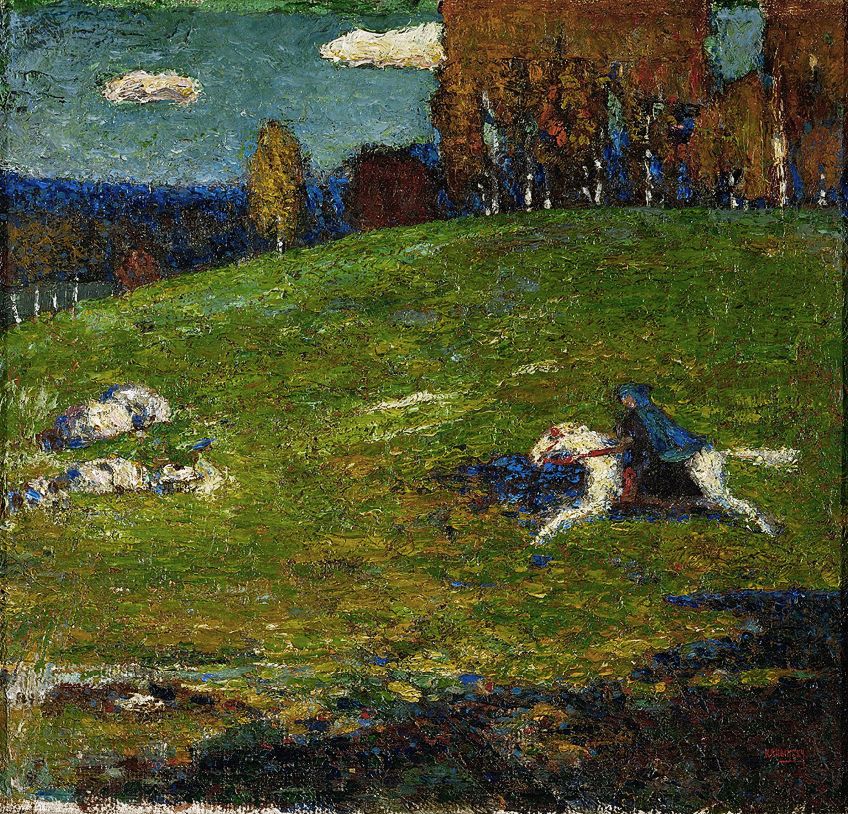
Der Blaue Reiter shows a misleadingly simple image, as a lone horseback rider dressed in blue is depicted galloping through the fields. However, it represents a critical moment in Kandinsky’s growing pictorial language, as the sun-streaked hillside reveals his interest in contrasting lightness and darkness, in addition to him capturing both stillness and movement within the same image.
The work’s abstracted character invites viewers to interpret the scene, with this canvas becoming the symbol of the expressive possibilities that were welcomed by the Expressionism artists.
Franz Marc (1880 – 1916)
Another founding member of Der Blaue Reiter was German artist Franz Marc, who was fascinated with animals and known for his use of animal symbolism within his artworks. Practicing art as a painter, printmaker, and watercolorist, Marc was a key member of the Expressionist group who gave a deep emotional and psychological meaning to the colors he used within his works. Marc made use of the color blue within his most well-known works, as he believed it to symbolize potent masculinity and spirituality.
Marc depicted his animal subjects in a profoundly emotional way, with his work utilizing vivid colors in an attempt to move away from realistic depictions towards a more spiritual and authentic portrayal of his subjects. Due to the symbolism within color, Marc carefully selected his palette to accurately convey the emotive qualities he aimed to express, so as to correctly convey his vision.
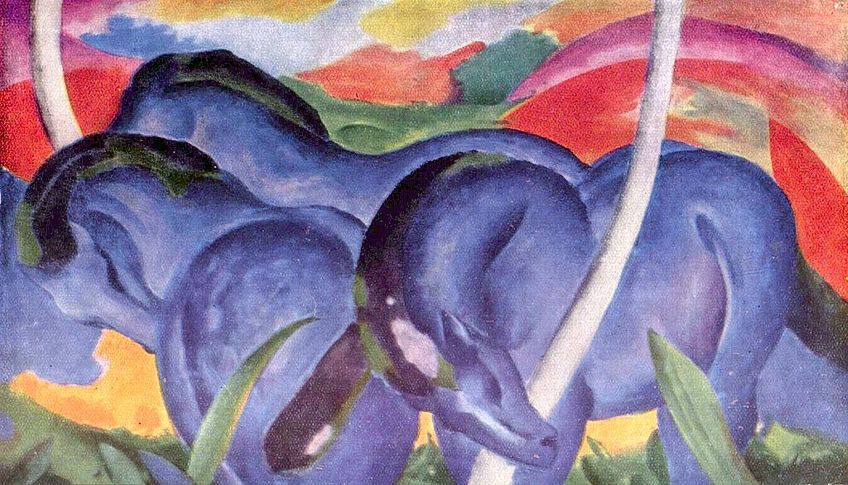
His most well-known work, painted in 1911, was titled Large Blue Horses and was shown in the first exhibition put on by Der Blaue Reiter. This artwork featured many vivid and contrasting primary colors encompassing the main subject, which includes three blue horses. The color of the horses, which was seen as symbolic, along with the soft curvature depicted within their bodies, established feelings of harmony, serenity, and balance against the harsh red hue of the background and hills.
Marc stated that this noticeable difference demonstrated the contrast that existed between peaceful spirituality and violence, with his serene artwork evoking a sense of superiority. This artwork, which made more use of bright colors and cubist techniques than some other artworks at the time, belonged to a series of works that centered around the theme of horses. Marc regarded horses to be symbols of spiritual renewal, hence their prominence within the series.
Ernst Ludwig Kirchner (1880 – 1938)
A notable artist belonging to Die Brücke was Ernst Ludwig Kirchner, whose work was typically defined by bold and blocking colors, wide and conflicting brushstrokes, and sharp-edged angular forms. Kirchner took inspiration from the works of post-Impressionist artists such as Edvard Munch, who influenced his use of expressive colors.
Kirchner was most famous for his numerous depictions of Berlin street scenes, with these scenes becoming the most famous within his catalog of work. Additionally, his most notable artwork, painted in 1913, came from this street scene category and was titled Street, Berlin. This artwork depicted Kirchner’s disdainful outlook on life in Berlin, demonstrated by the extremely sharp brushstrokes and unsettling color contrasts used.

Within this artwork, the faces of the subjects are indistinguishable from each other, which emphasized the empty superficiality of the high life in Berlin. A sense of claustrophobia and confusion is created from the way the figures are standing, as the titled ground implies that they are possibly falling out of the painting itself. In doing this, Kirchner created a remarkable portrayal of the alienation that existed in urban settings, which was emphasized through the interchangeability of the figures.
Without regard for a realistic interpretation of the form of the figures, Kirchner made a bold choice in positioning two prostitutes as the painting’s focal point. These two women, also unidentifiable except for their plumbed hats, add to the confusion and alienation that was innate to modern society due to the sudden loss of spiritual fellowship.
Kirchner emphasized the rapid development of urban culture by depicting individuals who were seen as “simple commodities” and prostitutes, who were considered worthy subjects.
As a founding member of Die Brücke, Kirchner established a new way of painting that visibly rejected Impressionistic inclinations and the need to accurately portray figures within paintings. This was demonstrated through his use of sharp colors, jagged brushstrokes, and lengthened forms that were adopted by members of Die Brücke to change the stylistic traditions of painting.
Karl Schmidt-Rottluff (1884 – 1976)
An additional co-founder of Die Brücke was Karl Schmidt-Rottluff, whose paintings represented the urban alienation and turmoil that existed within contemporary life at the time. His artworks were often exaggerated and sharp as he reduced the figures and scenes within his works to their simplest forms to produce what he viewed to be “authentic” expressions.
After Die Brücke began, Schmidt-Rottluff moved to Berlin where he began to paint scenes of the city. His most well-known work, titled Houses at Night was created in 1912 and depicted an abstract city block. Within this artwork, Schmidt-Rottluff depicted an unsettling empty street with buildings that staggered apart from each other at alarming angles. This was said to demonstrate the the alienation that was present in modern urban society.
The glowing colors of the buildings give off an intensity and energy that seems to seep away within the composition, creating an uncomfortable juxtaposition between the bright blocks and the empty street. Additionally, the primitive shape of the buildings permeates the canvas with a pervasive unease and alienation, which was depicted as the essence of modern life within this Expressionist painting.

Oskar Kokoschka (1886 – 1980)
A notable Austrian artist within the Expressionism movement was Oskar Kokoschka, who was best known for his intense landscapes and portraits. While Kokoschka refrained from adopting the techniques and ideologies that trademarked as German Expressionism art, he greatly admired the sense of community that was established between group members in their rebellion against traditional art.
His most iconic work was Hans Tietze and Erica Tietze-Conrat, which was commissioned by the esteemed art historians themselves and painted in 1909. Kokoschka focused on the inner drama that he observed in his subjects, as demonstrated by the nervous hands that were made into the central point of their anxiety within this work.
Kokoschka stated that his depiction of the couple was based on how he perceived their psyche as opposed to their physical attributes.
The colorful background and concentrated brushstrokes of the figures were representative of the techniques used within Expressionism, as well as the heightened emotion that Kokoschka included. Additionally, the swirling and abstracted colors obscured the background and enclosed the subjects in a frenzied and depthless depiction of space within the painting.
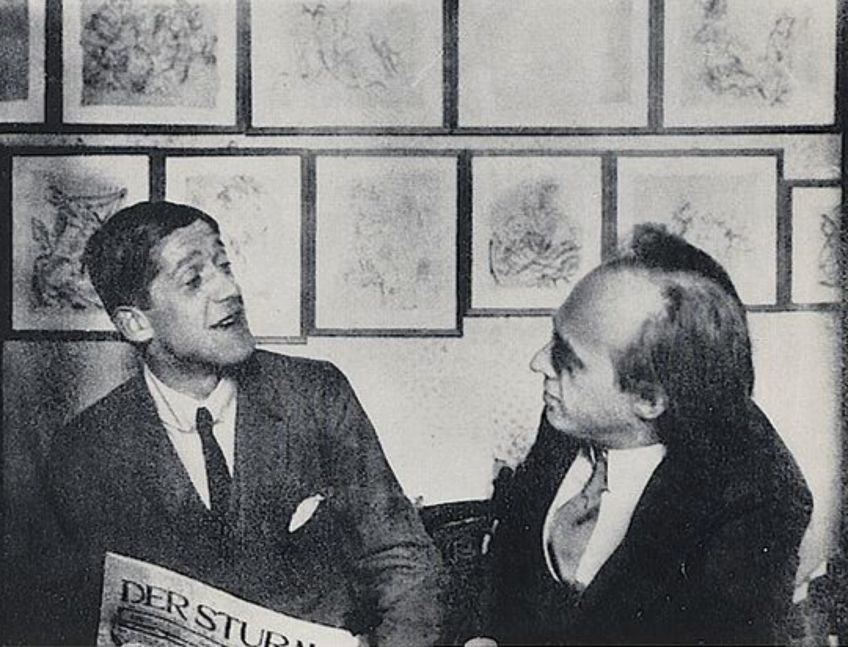
Egon Schiele (1890 – 1918)
Egon Schiele was another central figure of Austrian Expressionism. Schiele was known for his harsh and often grotesque depictions of sexuality within his artworks, as he was influenced by the controversial artistic manner of Gustav Klimt and his iconic painting, The Kiss (1907-1908). Displaying such overt eroticism as a major theme within his works often led Schiele to the scrutiny of harsh critics and he was even imprisoned for promoting “indecency” in his paintings in 1912.
However, his altercations with the law did not seem to deter him from his erotic depictions, as he continued to produce paintings with this central theme. Accordingly, Schiele’s most well-known work, painted in 1917, portrayed this theme and was titled Sitting Woman with Legs Drawn Up. Within this artwork, Schiele drew his wife, Edith, who was partially dressed and sitting on the floor with her body in an unusual position.
Her intense expression assuredly confronted viewers and contradicted the traditional standards of submissive feminine beauty. Due to this, the portrait is bold and suggestive, displaying definite themes of eroticism. Edith’s fiery red hair created a striking contrast with her vibrant green shirt, adding to the confidence she seemingly possessed. Additionally, her casual pose established an intimate moment with viewers, demonstrating the emotionality within the work.
Despite being blatantly controversial throughout his artistic career, Schiele is nevertheless recognized for the skills he possessed and the emotive quality of his line work and color choice, which placed him decidedly in the Expressionist movement. Thus, Schiele portrayed images exactly as he saw them as opposed to how they appeared to the outside world.
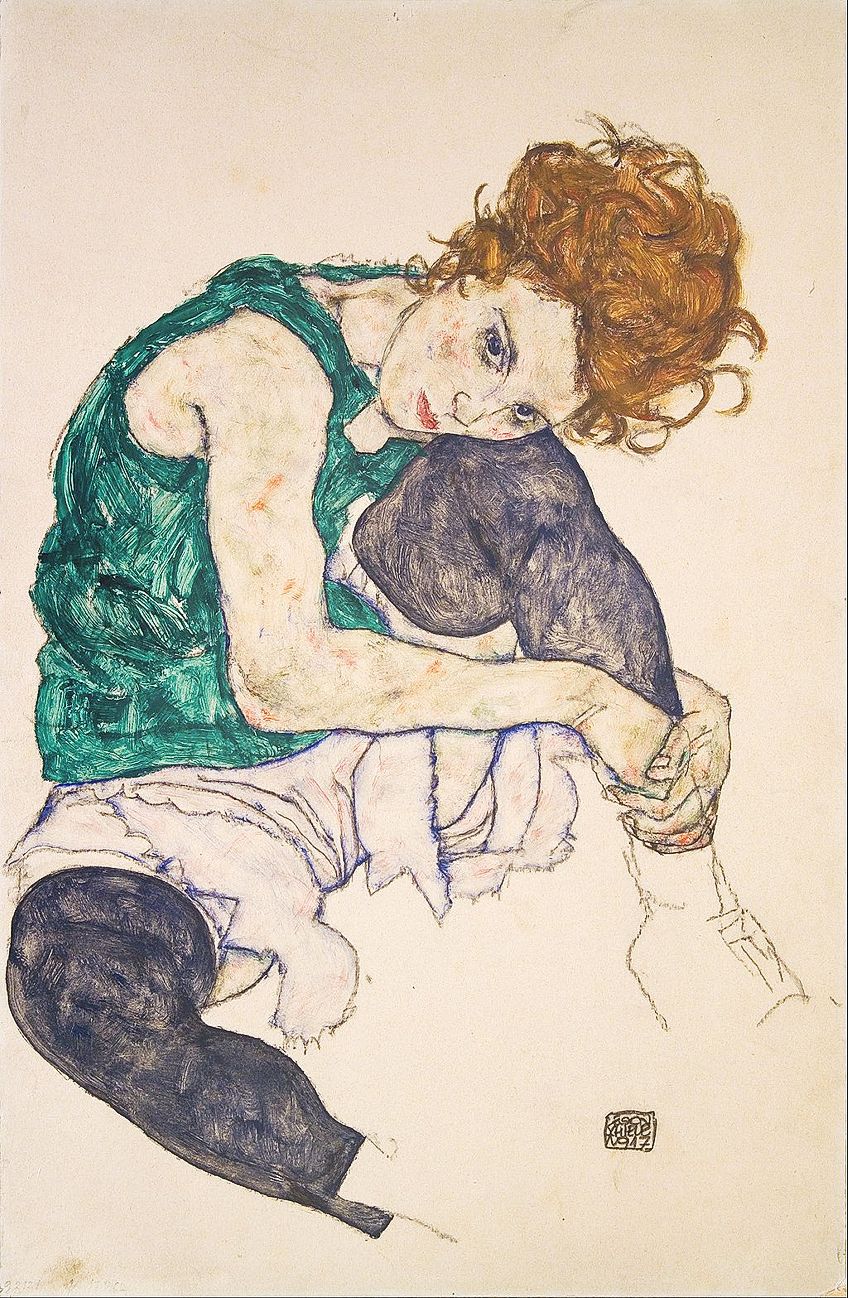
The Legacy of Expressionism Art
The Expressionism art movement was indeed revolutionary and wide-ranging, as it went on to inspire various offshoot movements and influence the development of Contemporary art. The Expressionist movement was not a discrete one since artists practicing this style experimented with techniques from other movements. This experimentation went on to affect several artistic genres which followed Expressionism, including Futurism, Cubism, Dadaism, and Surrealism.
Several Expressionists also lost their lives during World War I, either from fighting, trauma, or illness as a result of the war. Due to this, the movement fell out of favor within the immediate post-war period and was indefinitely closed by the Nazi dictatorship in 1933. Expressionist artists were labeled as degenerates by Nazis and their artworks were taken out of galleries and seized.
However, Expressionist art paved the way for the development of later art movements with its characteristics still existing in artistic practices today.
An important avant-garde development of Expressionism was Abstract Expressionism, which originated in the post-war era in the United States, between the 1940s and 1950s. In this style, artists explored powerful emotions through the use of striking colors and aesthetic brushstrokes, as demonstrated in the works of Jackson Pollock. After this, Neo-Expressionism started to develop in the late 1970s and 1980s as a reaction to the Conceptual art and Minimalist art movements that existed at the time, displaying the far-reaching influence of Expressionism.
Expressionism Art in Other Forms
Due to the rapid expansion of Expressionism art, this style influenced the development of a variety of other art forms. Of these different forms, the most notable artistic spheres, where characteristics of Expressionism can be seen includes cinema and drama.
Cinema
Within the German Expressionist movement, an important art form that developed was German Expressionist Cinema. The reason for its importance is because it was one of the first artistic genres that had a significant impact on the expansion of modern filmmaking, which allowed the development of numerous Avant-Garde styles that have taken place since then.
Initially, most Expressionist films were developed due to the alienation that Germany experienced leading up to the start of World War I, however, a demand for this experimental film genre soon began to grow and by the early 1920s, German Expressionist Cinema had reached an international audience. This led to many European filmmakers playing around with the techniques of Expressionist cinema when producing various films.
After experiencing the horrors caused by the war, Expressionist cinema began to blossom. Notable examples of this type of cinema include The Cabinet of Dr. Caligari, produced in 1920, The Golem: How He Came into the World, produced in 1920, and Metropolis, produced in 1927. All three films have a sinister and unsettling undertone, which was said to represent the turmoil and horror that existed within society after the war had ended.
Drama
The Expressionism movement was a powerful influence on the development of early 20th-century German theatre, with the most notable playwrights including Ernst Toller and Georg Kaiser. During the 1920s, Expressionism found its way to the United States, where it also had a significant influence over theater, with its influence extending into the development of early modernist plays.
In addition to producing visual art, Austrian Oskar Kokoschka was a playwright who wrote what has often been described as the first Expressionist drama. This play, titled Murderer, The Hope of Women, was written in 1909 and follows the story of an anonymous man and woman who struggle for dominance. Both individuals cause pain, with the man burning the woman while she stabs and imprisons him. He later frees himself and she dies at his touch. The man then murders everyone around him and the play ends on an unsettling note.
Expressionist plays often dramatized the spiritual awakenings and sufferings of their protagonists, with some playwrights using an episodic dramatic structure to heighten these emotions which were modeled according to the suffering and death of Jesus. Expressionist dramas also exaggerated the struggle against upper-class values and traditional authority, which was frequently embodied by the father figure within the plays.
Characters within Expressionist plays were simplified to mythic types, choral effects, theatrical dialogue that was rhapsodic yet clipped and elevated the emotional intensities of the story. These attributes became characteristics of later Expressionist plays. Additionally, the staging was an important element within these dramas, as directors chose to forgo the illusion of reality and lock actors in a two-dimensional space. Notable Expressionist playwrights to emerge from these developments include Tennessee Williams, Arthur Miller, and Samuel Beckett.
At the beginning of the 20th century, vast shifts in artistic styles and ideas broke out in response to the major changes that occurred within the structure of modern society. Due to the urbanization that occurred, as well as the outbreak of World War I, the perspective of individuals shifted significantly, with many artists reflecting on the landscape of their inner turmoil. Thus, artists tapped into incredibly raw and true emotions in an attempt to portray how the events of the world had affected society.
Frequently Asked Questions
What Is Expressionism?
The Expressionism art movement refers to artworks that focused on interpreting the intense inner emotions that were experienced by artists and society at the time, as opposed to physical reality. Artists focused their works on depicting these emotions accurately, which were in response to the mass urbanization that had occurred, as well as the beginning of World War I. The Expressionism years spanned from 1905 to around 1920.
What Is a Suitable Expressionism Art Definition?
Due to the Expressionism art movement being so broad, it was somewhat difficult to accurately define. Expressionism overlapped with a variety of other art movements, with some of these techniques making their way into Expressionism art. Thus, an appropriate definition encompasses art that valued emotional expression over the depiction of Realism.
Which Painters Were Well-Known Within the Expressionism Art Movement?
Important artists of the Expressionism art movement included Wassily Kandinsky, Ernst Ludwig Kirchner, Franz Marc, Karl Schmidt-Rottluff, Oskar Kokoschka, and Egon Schiele. Additionally, two important precursors to the movement were Edvard Munch and Vincent van Gogh.
What Artistic Groups Developed in Response to Expressionism?
Within the Expressionism movement, German Expressionism was a significant development in Berlin. The two groups falling under this movement were classified as Die Brücke (1905-1913) and Der Blaue Reiter (1911-1914).
Isabella studied at the University of Cape Town in South Africa and graduated with a Bachelor of Arts majoring in English Literature & Language and Psychology. Throughout her undergraduate years, she took Art History as an additional subject and absolutely loved it. Building on from her art history knowledge that began in high school, art has always been a particular area of fascination for her. From learning about artworks previously unknown to her, or sharpening her existing understanding of specific works, the ability to continue learning within this interesting sphere excites her greatly.
Her focal points of interest in art history encompass profiling specific artists and art movements, as it is these areas where she is able to really dig deep into the rich narrative of the art world. Additionally, she particularly enjoys exploring the different artistic styles of the 20th century, as well as the important impact that female artists have had on the development of art history.
Learn more about Isabella Meyer and the Art in Context Team.
Cite this Article
Isabella, Meyer, “Expressionism Art – A History of the Expressionist Movement.” Art in Context. April 13, 2021. URL: https://artincontext.org/expressionism-art/
Meyer, I. (2021, 13 April). Expressionism Art – A History of the Expressionist Movement. Art in Context. https://artincontext.org/expressionism-art/
Meyer, Isabella. “Expressionism Art – A History of the Expressionist Movement.” Art in Context, April 13, 2021. https://artincontext.org/expressionism-art/.



